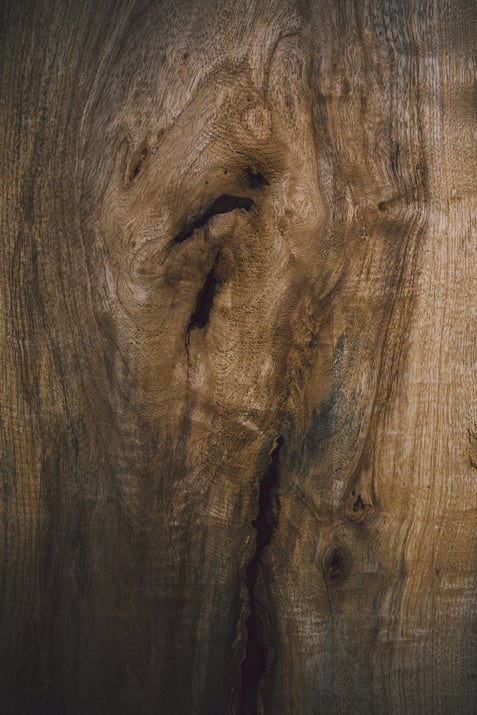Everyone wants the natural, classic look of wood flooring in their home. But they don’t want the price tag that comes with it. “Wood-look” is an emerging trend in the flooring industry because it’s budget- and family-friendly while still maintaining quality.
Thanks to recent technological and manufacturing advancements, “wood-look” flooring has become even more popular than traditional hardwood. In the past, faux-hardwood was looked down upon for its fake, plastic-y feel. Today, even experts have trouble telling the difference between solid hardwood and laminate or tile. You’ve likely seen wood-look flooring yourself without even realizing the difference.

What are the wood flooring options?
“Wood-look” is an alternative to the traditional hardwood. Although hardwood is the gold standard for quality flooring, it has an immense price tag ranging from $8 to $25 per square foot.
Engineered wood is another hardwood option, made from “leftover” wood that has been compressed and repurposed. It’s slightly less expensive, and it’s more sustainable and stable than solid wood. However, engineered wood floors last only 20 years maximum and can only be re-sanded once. In the long-haul, engineered wood doesn’t always give the best bang for its buck.
That’s where wood-look flooring comes in. Wood-look is a non-wood flooring that is manufactured to look like hardwood. There are two main types of wood-look: laminate vinyl and porcelain tile.
Laminate vinyl
Laminate is what you traditionally think of when you think of faux hardwood flooring. But throw your preconceived notions aside. Tech advancements have changed the look and feel of laminate to make it more wood-like and realistic.
Laminate vinyl is a photo of wood that is laminated onto vinyl flooring. Laminate vinyl can come in sheets, tiles, or planks. The price is significantly less than hardwood, with luxury vinyl tile coming in at $2 to $5 per square foot.
Porcelain tile
Porcelain tile is manufactured to look like tiles of hardwood. It’s clean and sleek and doesn’t need to be refinished. Porcelain is tougher than ceramic, and it won’t scratch, dent, or fade. Furthermore, it can be used with heated flooring technology if you were thinking of installing that in your home. Wood-look tile is often manufactured in long planks to simulate natural wood. It generally costs $4 to $9 per square foot, which is near the same low price tag as laminate vinyl.


What are the benefits of wood-look flooring?
-
Cost
The biggest advantage of wood-look flooring is the price tag. It’s significantly more budget-friendly than hardwood.
-
Practicality
Traditional hardwood floor is not recommended for “wet” areas because the moisture and humidity could damage, stretch, and stain the wood. Vinyl and tile are water-resistant, though, so you can have “hardwood” floors in the bathroom and kitchen as well.
You can even use vinyl sheets and tile on the wall. This makes it the perfect solution for a rustic home design without the extensive cost of installing wood on your walls.
-
Durability
Hardwood scratches, warps, and damages easily. Wood-look flooring is generally durable and resistant to injury. This makes it more sensible for settings with a lot of usage and traffic. Wood-look flooring is a great option for commercial settings that have high traffic and environmental pollutants.
-
Low maintenance
Vinyl and tile require less maintenance than hardwood, which typically requires extensive cleaning and upkeep. If you have hardwood floors, check out our wood cleaning machines to make maintenance 5x easier!
-
Design
You can match your wood-look floor with just about any décor or design. Wood-look floors are photographs imprinted on top of flooring, which means that the only limitations are your imagination (and photography).
There are a variety of colors and styles available to you to perfectly match and customize your room’s style. Plus, you can even have rare- or exotic-looking wood flooring at a low cost.
-
Easy installation
Installing hardwood usually takes a team of skilled professionals. Vinyl and porcelain tiles can even be installed by an eager DIY-er! Learn how to install vinyl flooring here. Furthermore, wood-look projects are usually completed faster and with fewer errors than solid hardwood installation.
What are the disadvantages of wood-look flooring?
There are usually only two concerns with wood-look flooring.
Hardwood, if properly maintained, can add value to your house, especially when you go to sell your home on the market. Vinyl and tile don’t add value to your house. But they don’t detract from the value either!
You should not use sheets of vinyl for larger areas. Because these floors replicate wood with specific photos, they can have repeat patterns. This can give a fake, unnatural look to the floors. Planks and tiles also have photograph images, but they’re easier to mix up so they don’t look as repetitive.
The Bottom Line
Because of significant advancements in the flooring industry, laminate and tile can look, feel, and even sound exactly like hardwood floors. Wood-look floors win out over traditional hardwood in terms of value, durability, practicality, maintenance, and décor.
What are your thoughts on wood-look flooring? Let us know in the comments below!

3 comments